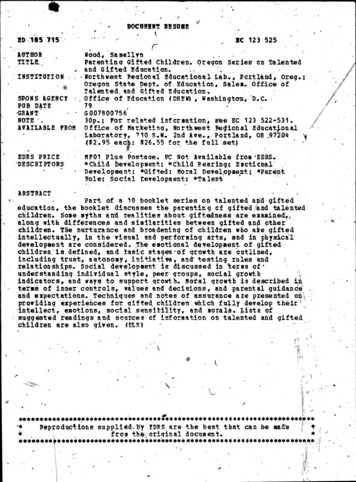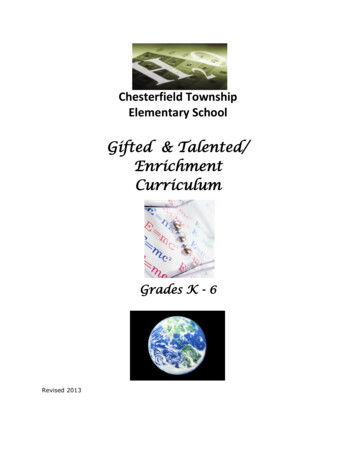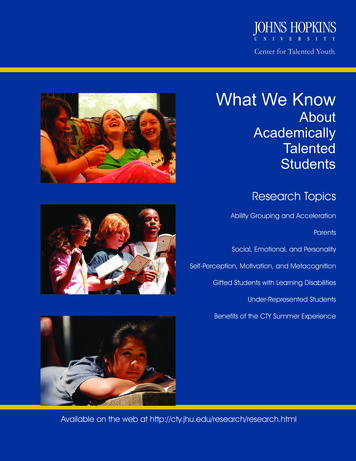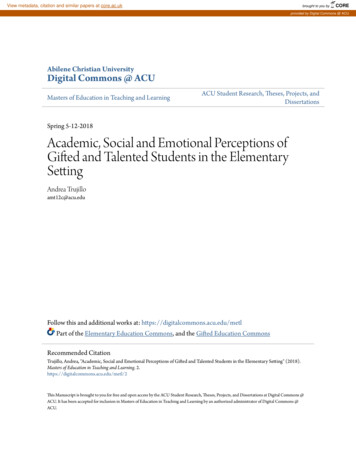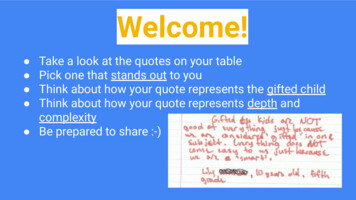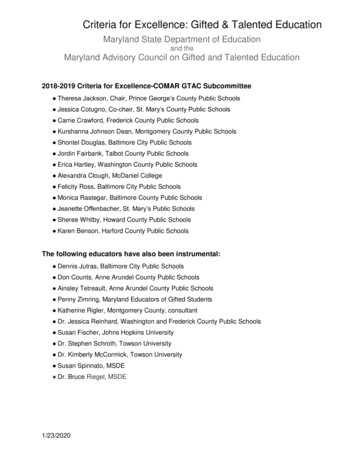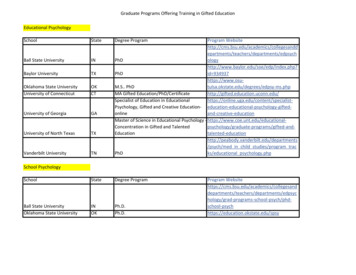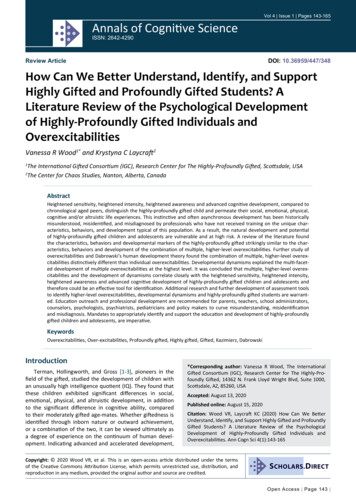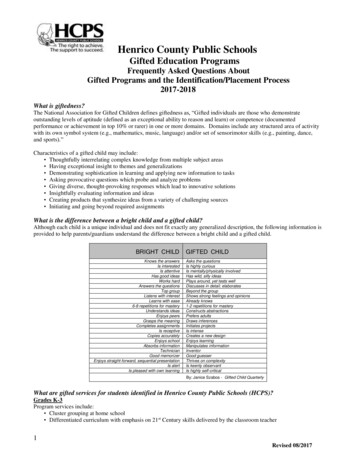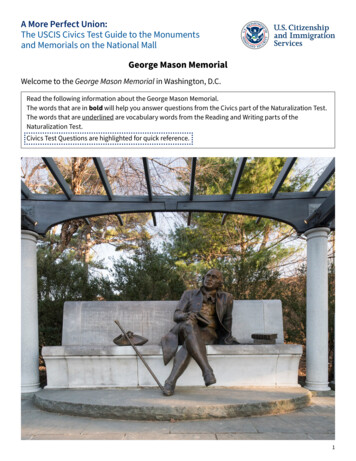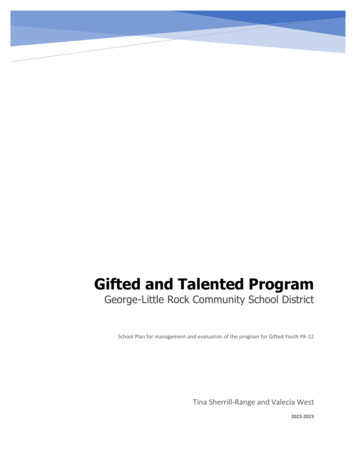
Transcription
Gifted and Talented ProgramGeorge-Little Rock Community School DistrictSchool Plan for management and evaluation of the program for Gifted Youth PK-12Tina Sherrill-Range and Valecia West2022-2023
GIFTED AND TALENTED PROGRAMPhilosophyA fundamental premise underlying our society is a belief in the intrinsic worth of every individual. It isgenerally conceded that education is a vehicle by which each and every individual may advance towardshis/her fullest potential. The needs, interests, and readiness of high ability students require specialeducational considerations.A common denominator agreed upon by researchers and educators is that content and activities for highability students should be differentiated in the classroom and across building levels. In addition, apredominant objective in a program for high ability students is to motivate them with a desire forexcellence and lifelong learning. This program will provide extensions of learning which allow exploration,experiences, and expression beyond the regular classroom.Gifted and Talented activities and opportunities are necessary to assist students in accessing andcapitalizing upon unique abilities, talents, and needs. In addition, individual learning styles are reinforcedby resources and tasks which are differentiated in content and intent. It is also important to includeaffective education with cognitive learning characterized by diversified opinions and beliefs.As an outcome of their education, high ability students should increase their (higher level) thinking skills,problem solving skills, goal setting, creativity, divergent thinking, and tolerance for ambiguity.Definition of Gifted and Talented StudentsGifted and talented children are those identified by professionally qualified persons. Gifted and talentedchildren, by virtue of outstanding abilities, are capable of high performance in the areas of generalintellectual ability, creative thinking, leadership ability, visual and performing arts ability, and specificability aptitude.Iowa Code section 257.44 defines gifted and talented children.Mission of Gifted and Talented EducationThe mission of the George-Little Rock Gifted and Talented Program is to provide challenge, enrichment,and a differentiated curriculum to meet the academic, social, and emotional needs of gifted and talentedstudents as defined by the school district to maximize the students’ potential.1
Student Goals for the Gifted and Talented Program: Elementary and Middle Schools1.2.3.4.5.The gifted learner will acquire advanced knowledge and comprehension skills to gather,understand, analyze, and apply information and abstract ideas with a greater degree ofindependence.The gifted learner will acquire knowledge and skills to communicate abstract ideas effectivelywithin and beyond the classroom.The gifted learner will use critical, creative, analytical, and organizational thinking skills torecognize and solve problems.The gifted learner will acquire strategies and skills to make decisions in order to act as aresponsible member of a global society.The gifted learner will develop an understanding of himself/herself and unique interests thatfoster a feeling of belonging to society so as to reach intellectual potential.Student Goals for the Gifted and Talented Program: High SchoolA. Student outcomes1. To nurture the development of the student’s role as a lifelong learner andproductive member of society (affective education)2. To broaden perceptions of the student’s diversified opinions and beliefs (multicultural/genderfair)3. To assess and capitalize upon the student’s unique abilities, talents, interests, needs andlearning styles4. To develop the student’s skills for independent study, higher level thinking, creativity, problemsolving, research, technology, and goal setting5. To broaden the student’s awareness of college and career optionsB. Curriculum and Instructional strategies1. To provide a differentiated educational program beyond the regular classroom which willmeet each identified student’s needs/learning style(s)2. To provide extensions of learning which can afford the high ability students open circuits forexpressing, exploring, and experiencing opportunities according to their creative and cognitivecapabilitiesGLR Gifted and Talented Program Management and Development: TK - 12A. Program Management1.To collaborate with the business community, volunteers, and colleagues2.To utilize available community and school resources3.To follow a program evaluation cycleB. Program Development1.To extend the use of community resources2.To extend use of technological resources3.To continue assistance to classroom teachers4.To continue curriculum expansion, differentiation, and enrichment5.To continue service learning2
Gifted and Talented Program ModelGLR CSD Talented and Gifted Personnel: The Gifted and Talented (TAG) Program is staffed by a .5 FTE ofhighly qualified, licensed individual(s). More than one individual can fill this position. In the GLRElementary School and Middle School, Grades TK-8, this position will be .355 FTE. In the GLR HighSchool, Grades 9-12, a .145 FTE will staff this position. A GLR District TAG Committee will consist of theTAG Teacher(s), two elementary teacher representatives, a middle school teacher representative, and ahigh school teacher representative. Any of the building representative positions on the Committee (otherthan the TAG teachers) may be filled with a corresponding building principal or corresponding buildinginstructional coach.Students will follow classes, instruction, and coaching in the following program format:1. Program begins shortly after school resumes in the fall.2. Grade levels involved at present are grades TK-12.3. GLR Elementary School, Grades TK-6:The elementary gifted and talented program is split into two formats. TK and Kindergarten arewhole grade instruction that focuses on higher order thinking skills. Additional staff discussion willcenter on students displaying additional needs. Possible topics will include how to best meet theneeds of students and assign pullout/mentor interventions as needed.4. In 1st grade the program transitions to the pullout format. In this format the students who areidentified in the gifted and talented pool will leave their classroom at a scheduled time and go tothe gifted and talented room for 30 minutes each week. The students will participate in adifferentiated curriculum which will be supplementary to their grade level curriculum. Pulled outgroupings will be 1st and 2nd, 3rd and 4th, and 5th and 6th grades. They will be working with otherstudents as well as doing independent study, as time permits.5. In addition, there is a variety of activity possibilities for all students in Grades TK-6 within thewhole classroom setting. Some options are whole class higher level thinking skills, group workwith high ability reading students, group work with high ability mathematics students, and groupwork with high ability spelling students.6. Seventh and eighth grade students meet for flexible sessions throughout the year to accomplishgroup and individual projects.7. High School students meet at least three times each year. Additional sessions are scheduled asneeded for individual projects.8. The number of students involved in the program varies each year. A “revolving door” policy is ineffect. A student, and/or parent/guardian, and/or teacher may request an exit and re-entrance tothe program for appropriate reasons.9. Student evaluations are made each semester. Evaluations are made available to parents andteachers during parent teacher conferences.3
PROGRAM CURRICULUMElementary and Middle School:1. Short and long-term projects/activities2. Individual, small group and large group activities3. Affective education – working with self-knowledge and relationships with others4. Enriching higher level/critical thinking skills5. Strengthening self-directed learning skills6. Fostering creative thinking skills7. Strengthening of independent study and research skills8. Participation in individual learningHigh School:1. Individual conferencing2. Class scheduling assistance (for example Dual Enrollment Classes)3. College prep4. Informal group sessions5. Participation in individual learning and projectsIdentification ProcessThe talent pool identification process will begin in 1st Grade. Student(s) must acquire three of thefollowing requirements to be accepted into the Talent Pool.1. Staff will review the periodical local testing data and the Iowa Statewide Assessment of StudentProgress (ISASP) data. Requirements will be determined from this data.2. Written teacher recommendation with an artifactNote: Artifacts are examples of student work that display outstanding achievement.3. Written parent recommendation with an artifact4. Written student recommendation with an artifact and interview with the GLR District TAGCommittee.5. Other valid tests or assessments that show achievement in a non-academic area (creativity,leadership, music, and/or art). Content area specialists may administer these assessments.Student(s) who meet three of the criteria above are considered “Talent Pool Students” and will take theCognitive Abilities Test in 3rd grade to assess their abilities. They must score a 7 or higher in two of thethree areas on the CogAT to be admitted to the program. Some students may be asked to have aninterview or be assessed in another way depending on the students’ areas of giftedness to attain theinformation about the students. The District TAG Committee will use all information compiled for eachstudent and decide whether to admit students into the Gifted and Talented Program.In 1st grade, students that are considered in the GLR Talent Pool will begin to be pulled out for class.Students will be re-evaluated at the end of their 6th grade year. Once admitted after their 6th gradeschool year, students will not be asked to go through the identification process again. However, studentswho have not qualified for the program may be identified after their 6th grade school year as theirsituations and needs arise. Students who are in grades 1-2 will be identified based on scores in readingfluency, reading comprehension, and basic mathematics scores from classroom formative assessments.These lower-elementary students may qualify for the pull-out program if their needs require moreindividualized instruction.4
Underrepresented PopulationsThe identification process shall provide equitable opportunities for the District TAG Committee to discussand include students from Culturally Linguistically Diverse backgrounds (CLD), English Learners (EL),Twice Exceptional (2E), as well as students who exhibit behaviors such as shyness, underachieving,ADD/ADHD, disruptiveness, or continual questioning. Throughout the identification process, carefulconsideration will be made with all available information.Exit ProceduresOnce a student is placed in the gifted and talented program, they will most likely continue in theprogram. However, it may be in the best interest of the student to exit from the program. Parents orguardians will be notified and involved in intervention strategies before and during the process. The finalexit decision should be based on educational, psychological, and personal reasons with no single criterionacting as the determining factor for exiting the student. If a formal exit is deemed appropriate by theDistrict TAG Committee, parents or guardians will be notified and at least one signature will be required.Evaluation of the Gifted and Talented ProgramInformal surveying will accomplish evaluation of the TAG Program. Students in the middle and highschools who are involved in the program will be given a student survey in grades six, eight, and eleventhat evaluates the program and effectiveness. Parents/guardians of students in the TAG Program will begiven an opportunity to evaluate the program on its effectiveness, communication, scheduling, and anyproblems with the program model. Teachers, as well as the District TAG Committee, will have anopportunity to evaluate the program on an annual basis. These surveys will be done anonymously andwill be reviewed by the TAG Committee. The Committee will use the surveys to identify strengths andweaknesses and do its best to find solutions to any problems or weak areas defined by the students,parents/guardians, and teachers.5
ResourcesIowa Talented and Gifted AssociationPO Box 665Iowa City, IA 52244www.iowatag.orgBelin-Blank CenterThe University of Iowa600 Blank Honors CenterIowa City, IA belinblank/Northwest Area Education AgencyGifted Education Consultant(s)800-352-9040www.hoagiesgifted.orgThis website supports and informs parents and teachers about gifted education and resources.https://eric.ed.govThis website provides research on gifted education.This is a database for educational articles.Iowa Nondiscrimination Statement – “It is the policy of George-Little Rock Community School District not todiscriminate on the basis of race, creed, color, age, sex, sexual orientation, gender identity, national origin,disability, marital status, socioeconomic status, or religion in its programs, activities, or employment practices asrequired by the Iowa Code section 216.7 and 216.9. There is a grievance procedure for processing complaints ofdiscrimination. If you have any questions or grievances related to compliance with this policy by George-LittleRock Community School District, please contact Reid Geerdes, Equity Coordinator, George-Little Rock CommunitySchool, 500 E. Indiana Ave., George, IA 51237; phone number 712-475-3311, email: rgeerdes@georgelittlerock.org. Iowa Civil Rights Commission, Grimes State Office Building, 400 E. 14th St., Des Moines, IA50319- 1004; phone number 515-281-4121, 800-457-4416; website: https://icrc.iowa.gov.To file a complaint of discrimination, write USDA, Director, Office of Adjudication, 1400 Independence Avenue,SW, Washington, D.C. 20250-9410 or call 1(866) 632-9992 (Voice). Individuals who are hearing impaired or havespeech disabilities may contact the USDA through the Federal Relay Service at 1(800)877- 8339 or 1(800)845-6136(Spanish). USDA is an equal opportunity provider and employer.6
7
Gifted and Talented Program Model GLR CSD Talented and Gifted Personnel: The Gifted and Talented (TAG) Program is staffed by a .5 FTE of highly qualified, licensed individual(s). More than one individual can fill this position. In the GLR Elementary School and Middle School, Grades TK-8, this position will be .355 FTE. In the GLR High
